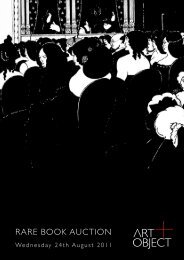Create successful ePaper yourself
Turn your PDF publications into a flip-book with our unique Google optimized e-Paper software.
69<br />
Stephen Bambury<br />
Necessary Correction VII<br />
acrylic and resin on two aluminium panels<br />
title inscribed, signed and dated 1995 verso<br />
1170 x 852mm<br />
Exhibited: ‘Necessary Correction:<br />
Colin McCahon, Helmut Federle and<br />
Stephen Bambury ’, Auckland Art Gallery,<br />
September – October 1997.<br />
Illustrated: Wystan Cur<strong>now</strong> and<br />
William McAloon, Stephen Bambury<br />
(Craig Potton Publishing, 2000),<br />
pp. 212 – 213.<br />
$25 000 – $35 000<br />
Necessary Correction is a loaded term. What is being corrected? Why is it necessary?<br />
Many abstract paintings seek to elude a linguistic entry point by assuming the moniker<br />
‘untitled’, saying in effect, ‘take me for what I am, without the baggage of language.’ Untitled<br />
is a roadblock designed to free the image from quotidian interpretation and can be viewed<br />
as a coercive device which renders the viewer mute (hopefully in admiration).<br />
It is hard to find many ‘Untitleds’ in Stephen Bambury’s oeuvre. Quite the opposite. With the<br />
Necessary Correction series it could be argued he is leading with his chin; asking for it!<br />
‘It’ in this case is a direct comparison with the heavyweight champ of New Zealand painting,<br />
Colin McCahon. Bambury is stepping into the ring so to speak with McCahon’s Necessary<br />
Protection series of the 1970s.<br />
What Bambury seeks to correct was a prevailing view that locked MCahon into a New<br />
Zealand-centric discourse and out of a wider and deeper conversation about modernist<br />
abstraction. In other words Necessary Correction is a protest painting.<br />
Bambury is asserting for McCahon and New Zealand art an international context and his<br />
correction seeks to ack<strong>now</strong>ledge a modernist abstract lineage which runs from Malevich to<br />
Mondrian, through Barnett Newman via McCahon to Bambury himself.<br />
He explains his thinking in an interview with curator Robert Leonard in 1999, ‘It wasn’t<br />
a matter of what McCahon was for but what the culture said he was for. McCahon was<br />
somewhere else. He was an astute reader of international art, all art, yet you had this official<br />
programme of reception mounted against that, against his classically modernist project of<br />
synthesis.’ 1<br />
Whilst the connection to McCahon is placed front and centre by the title of the work, the<br />
conversation does not stop there. Bambury constantly alludes to a global consciousness in<br />
his work that is reverential in nature but not specific in a denominational sense. This has lead<br />
to his work being hung alongside Russian icons and discussed in terms of the iconography<br />
of many different eastern and western religions.<br />
His work is open to the devotional impulse as well as the conceptual pillars of modernist<br />
abstraction and of course the post-modernist urge to re-contextualize ‘old school’ debates<br />
within the contemporary discourse. A broad church indeed.<br />
It is the combination of the finesse and the sincerity of Bambury’s approach that ensures<br />
Necessary Correction rises to be much more that an in-house, art-world polemic, but a fully<br />
resolved modern wonder that is both world famous in New Zealand and a star in a larger<br />
cosmos.<br />
Hamish Coney<br />
1 Stephen Bambury in conversation with Robert Leonard,<br />
Bambury ‘Works 1975 – 1999’ Catalogue, City Gallery,<br />
Wellington, Lara Strongman editor, 1999.<br />
42

















